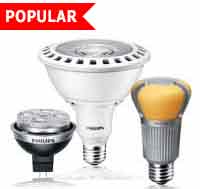Energy adviser: Learn to speak ‘light bulb’ and save some cash
Clark Public Utilities energy counselors have been fielding questions from consumers and business owners about lighting technology for several years as new and more efficient products have come to the market. Learning to speak “light bulb” is an ongoing challenge for those who want to wisely spend their money and learn about the trade-offs between old and new technologies.Understanding your lighting options became a bit more complicated late last year when Congress voted to delay the planned phase-out of incandescent light bulbs in favor of more efficient compact fluorescent lamps and light-emitting diode lighting.
Experts say the move, which allows the continued manufacturing and sale of traditional bulbs, will likely slow the transition to the new technologies but not derail it.
Switching two incandescent bulbs to two CFLs would save $102 in 10 years. The calculation includes purchase costs, replacement costs and energy use at three hours a day.
What else should consumers know?
• CFLs represent the best value for consumers today, because they use about 75 percent less energy than standard incandescent bulbs and last up to 10 times longer. A CFL that has the Energy Star label can save more than $40 in electricity costs over its lifetime.
• Consumers who replace still-working traditional bulbs with Energy Star CFLs can recover their costs in about six months. After that, they will continue to benefit from the 75 percent energy savings each bulb offers, and they won’t have to change the bulbs for about nine years.
Utility customers can receive a free CFL bulb for every old bulb they recycle -- limited to six per household -- at 1200 Fort Vancouver Way, 8600 N.E. 117th Ave., and 100 Columbia Way, all in Vancouver.
How to compare
Instead of watts, consumers should compare lumens. A lumen measures how much light a bulb will provide, whereas watts measure how much power it uses.• If you used to buy 100 watt bulbs, look for a bulb with 1600 lumens.
• If you used to buy 75 watt bulbs, look for a bulb with 1100 lumens.
• If you used to buy 60 watt bulbs, look for a bulb with 800 lumens.
• If you used to buy 40 watt bulbs, look for a bulb with 450 lumens.
What about LEDs?
LED light bulbs have the potential to last more than 20 years and save 75 percent on energy costs. However, their initial cost is higher than CFLs. LEDs are still new to market, with only a few 40- and 60-watt replacements available. As sales increase, production costs likely will come down and they will get brighter, cheaper and more energy efficient, experts say. But many LEDs haven’t received the Energy Star label because they do not meet one or more of that program’s performance requirements. An exception to this would be holiday and seasonal lighting, where LED bulbs provide much greater efficiency and comparable brightness to traditional strands.












Comments